Medical expert of the article
New publications
Hair transplant methods
Last reviewed: 06.07.2025

All iLive content is medically reviewed or fact checked to ensure as much factual accuracy as possible.
We have strict sourcing guidelines and only link to reputable media sites, academic research institutions and, whenever possible, medically peer reviewed studies. Note that the numbers in parentheses ([1], [2], etc.) are clickable links to these studies.
If you feel that any of our content is inaccurate, out-of-date, or otherwise questionable, please select it and press Ctrl + Enter.
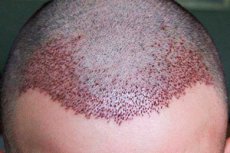
Hair transplantation is a procedure in which hair from one part of the head is transplanted to another part where it is missing for some reason, presenting a serious cosmetic defect. The operation is performed on an outpatient basis in rooms equipped with special equipment for hair transplantation (forceps and other surgical instruments) and anesthesia.
Usually, local anesthesia is sufficient for the procedure, when the person remains conscious, but does not feel pain in the area of the operation. But if the volume of work is large, i.e. hair is missing on a large area of the head or body, general anesthesia is allowed, after all, the transplant is not carried out with a large area of skin, but with individual bulbs, and therefore takes a lot of time. In this case, the procedure is carried out under the supervision of an anesthesiologist. His presence is also mandatory if the patient has a predisposition to high or low blood pressure, allergic reactions, with some concomitant diseases, and also if the patient is overweight or old.
It would seem that to get hair of normal thickness, you need to take a huge piece of tissue densely populated with bulbs, which means there should be a large scar. In fact, everything is not so sad. The fact is that usually the bulbs are located on the scalp in small groups of 2-4 pieces, occupying microscopic areas on the skin, so it is not always necessary to even cut out a flap of skin with follicles.
But even if you take a section of skin with individual follicles, the location is carefully sutured, leaving behind a barely noticeable scar. And since the skin is usually taken from an area with thick hair, the scar remains covered by the rest of the hair.
Usually, hair for transplantation is taken from the occipital and lateral parts of the head. Their choice is due to the resistance of the bulbs to negative external influences and the action of dihydrotestosterone, which is the reason for their normal growth throughout life. Bulbs from the frontal and parietal parts, on the contrary, are very sensitive, so they fall out first.
Extraction of natural follicular units using the follicular method with the use of special equipment with an implanter needle does not require the use of a scalpel or other micro-instruments that violate the integrity of the skin.
But taking such biomaterial as a skin flap according to the classical method requires the doctor to have skills in handling surgical instruments. Moreover, the flap must subsequently be cut into small pieces of skin containing from 1 to 4 hair follicles, which are inserted into prepared incisions on the bald part of the skin.
But enough general words, it’s time to consider what methods of hair transplantation exist.
FUT method or follicular unit transplantation
It involves a serious surgical operation. It is also called the flap method. The method has such a name because the biomaterial for transplantation in this case is a flap of skin cut from the back of the head.
The doctor trims the hair on the back of the head or the side of the head to make it easier to take the material for transplantation. The scalp at the site of the operation is treated with an antiseptic. The patient is given anesthesia (local or general anesthesia). When it takes effect, a scalpel is used to cut out a section of skin no larger than 10 by 3 cm on the back of the head, densely supplied with hair follicles, which is then divided into grafts (flap units containing 1-4 hair follicles). The site of the operation on the back of the head is sutured.
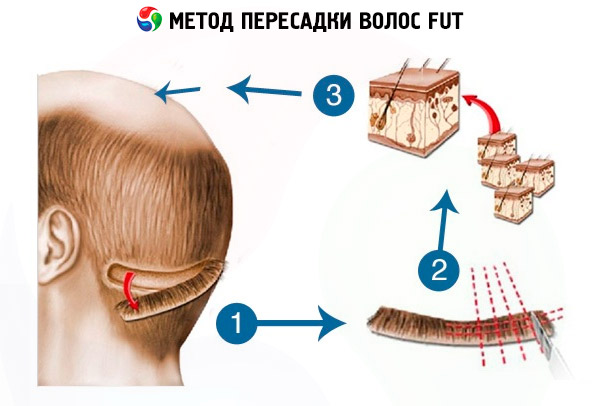
After this, incisions are made on the bald area, into which the prepared grafts are inserted, providing the necessary hair density. And it will again depend on the number of transplanted grafts. If the density subsequently turns out to be insufficient, additional operations are performed.
True, the method is considered quite traumatic, so a person can undergo the operation no more than 3 times in his life. A repeat operation can be performed no earlier than 6 months after the previous one.
A variation of this technique is the strip method, which involves extracting not a flap of skin, but a strip of about 20-25 cm in length. It is used when a person's initial hair density is insufficient to cover the balding area. The skin at the site of the flap is then sutured.
The advantages of these surgical techniques include:
- relatively short operation time (usually no more than 4 hours),
- the ability to achieve good hair density by obtaining and transplanting a large number of grafts (up to 12 thousand grafts in several procedures),
- a small percentage of damage to hair follicles during flap extraction,
- good survival rate of transplanted hair,
- relatively low cost of the procedure.
Among the disadvantages of strip methods are:
- a long period of wound healing at the site of the transplant; the recovery period, depending on the complexity of the operation, can take from 2 weeks to 3 months,
- loss of some follicles when taking biomaterial,
- a large, visible scar on the back of the head or sides of the head where the skin flap was taken,
- the presence of small scars at the site of the incisions where small transplants were inserted,
- pain at the site of surgery,
- Hair transplanted in one procedure usually does not provide natural density.
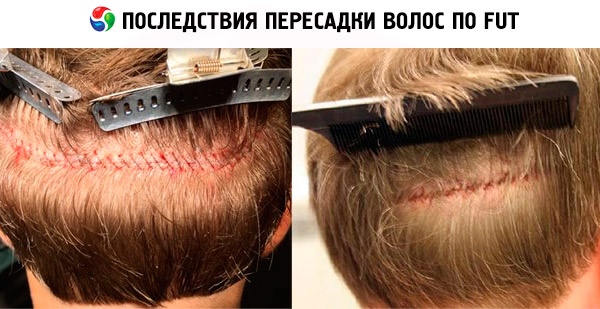
FUE method
A completely different technique from the strip. It is considered less invasive than the previous one, since it does not require any large incisions, which means there will be no stitches with visible scars.
FUE hair transplantation involves the use of special equipment - a punch, which pierces the skin, extracting small sections of 2-5 mm containing several hair follicles (follicular units). The procedure is also carried out after a haircut.
Next, micro-incisions are made on the diseased skin with a scalpel or punctures are made with a special needle, into which the individually removed grafts are inserted. Small red marks remain at the sites where the grafts were removed, which subsequently quickly heal and become invisible.
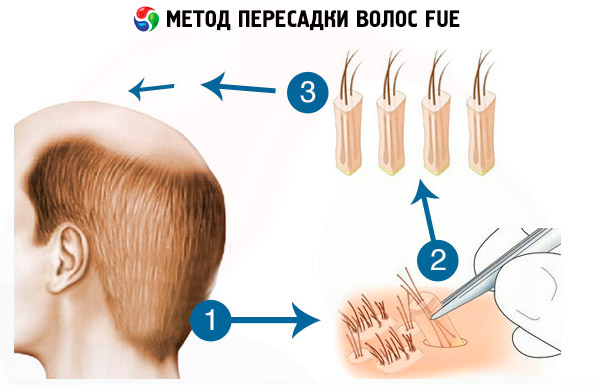
The FUE method (seamless hair transplant) is recommended for baldness up to stage 4. Otherwise, if there is insufficient biomaterial, the bulbs will have to be taken from other parts of the body (chest, legs, beard, pubis, etc.). Hair transplantation from the body subsequently leaves no visible traces in the places where the transplant was removed, but it is important to understand that the structure of the regrown transplanted hair (those taken not from the head area) will differ from others, they are stiffer and thicker.
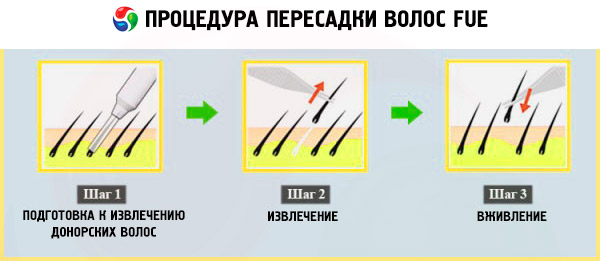
This method can also be used to restore eyebrows, moustaches, beards, eyelashes, etc., as well as to build up hair on healed burn surfaces.
The advantages of this technique include:
- less traumatic compared to strip,
- absence of large scars after surgery,
- the presence of almost invisible marks instead of micro scars in place of the bald spot,
- less pain in the postoperative period and its shorter duration (usually up to 4 weeks),
- the ability to use donor areas other than the head,
- Grafts obtained using the FUE method contain a larger number of hair follicles (when the skin is cut into small areas using the strip method, they usually contain 2-3 follicles, while with FUE, multi-component follicular units containing 3-4 follicles are extracted).
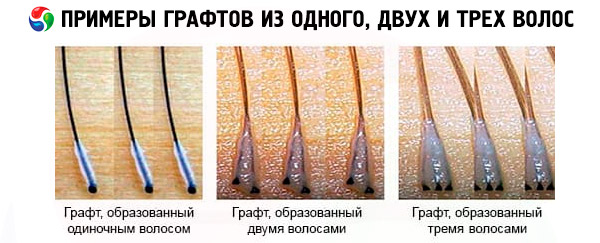
Despite the lower trauma and more attractive appearance of the patient’s head after transplantation, the FUE technique also has serious disadvantages:
- the duration of the operation is 2 times longer than that of strip methods,
- the FUE method allows for a smaller amount of hair to be transplanted from the scalp in one procedure, which will correspond in structure to the non-transplanted hair (up to 6 thousand grafts),
- impossibility of repeat surgery,
- the number of bulbs damaged during removal is higher than with the strip method,
- transplanted hair is damaged during the process of being removed and implanted back into the skin, which means its survival rate may be lower,
- The price for a seamless FUE operation is higher because the doctor has to work hard, extracting follicular units one by one instead of cutting off a section of skin and giving it to assistants who will cut it into pieces.
In some clinics, doctors offer a modernized version of the Strip and FUE methods, when the hair is not cut before transplantation. As a result, after the operation, the person receives a virtually finished hairstyle, and the doctor - the opportunity to evaluate the result of his work. At the same time, the person has the opportunity, having covered the shortcomings (traces of punctures and incisions) with hair, to immediately lead his usual active life.

True, there are a couple of nuances here. Working with long hair is a more labor-intensive process that requires certain skills and experience, which not all specialists in this industry have. And the cost of such an operation can be significantly higher than when working with short hair.
HFE Method
This is a modern technique, the name of which is decoded as manual extraction of the follicle (Hand Follicle Extraction). Sometimes the name of the technique is given a slightly different meaning, decoding the abbreviation Hair ForЕver, which should be understood as a beautiful hairstyle or hair forever. Perhaps because the name of the method is consonant with the only clinic in Russia, Hair ForЕver, which performs hair transplantation using this technique.
The HFE method is a hair transplant without surgical intervention, i.e. the doctor does not make even microscopic incisions. The entire procedure is carried out using a special instrument (an implanter needle, up to 0.9 mm in diameter, which extracts follicular units and implants them into the scalp in the balding area).
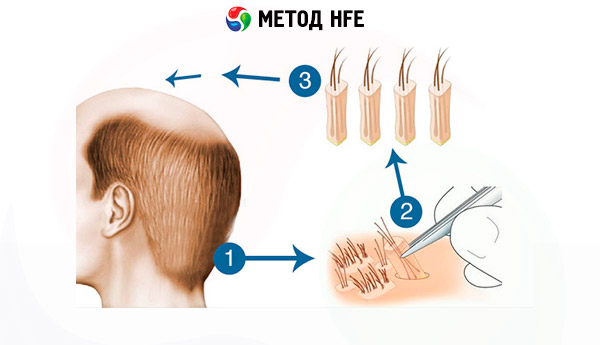
Using an implanter allows you not to make preliminary cuts on the skin, but to immediately transplant the bulb to a given depth (usually about 1 mm) from one area of the head to another, while adjusting the angle of the hair, bringing it as close as possible to the slope of the main mass of hair on a given area of the head. It is clear that there is no need for general anesthesia here, because the procedure is less painful and less traumatic. The duration of the operation may vary depending on the area being treated and the number of bulbs being transplanted.
Non-surgical hair transplantation using the HFE method is gaining more and more popularity, pushing previously existing methods into the background. And this is understandable, because it has many advantages over them:
- low tissue trauma, at the site of hair removal only thin punctures of small depth remain, which damage the nerve endings,
- the absence of any traces of the operation after the end of the recovery period and the need to stay in hospital after the operation for professional care of the sutures, as with strip technologies,
- quite a high percentage of hair survival (up to 98%),
- the ability to achieve the desired hair density in 1-2 procedures (in 1 procedure, a patient can be transplanted up to 6 thousand follicular units, consisting of 2-4 bulbs, which already provides a thick, beautiful hairstyle, but there is still the opportunity to carry out an additional procedure and double the hair density, which the FUE method cannot offer),
- short recovery period: wounds heal in 4-5 days, discomfort disappears within a couple of weeks,
- hair begins to grow actively after 3 months after the procedure, which is not always possible after using other methods,
- the possibility of hair transplantation to the forehead, which is relevant in cases of a very high forehead line and pronounced bald spots (the surgeon outlines the forehead line, where follicular units from the back of the head are implanted).
Many men consider a beard to be an indicator of masculinity, it is clear that its absence can cause certain complexes in a man, and this makes him seek help from specialists. The HFE method allows hair transplantation not only to the forehead and crown of the head, but also to other areas, for example, to the beard. After all, it allows you to achieve not only the desired density, but also the correct angle of the hair. In addition, there are practically no traces left in the places where the hair is introduced into the beard area, which is also important.
Using the HFE method, if you have no hair of your own, you can try to transplant hair from another person, but, as we have already mentioned, it does not always give the expected results. It is usually impossible to talk about the compatibility of biological parameters of other people's hair. In the vast majority of cases, this biomaterial is rejected by the recipient's body. You can try to take a close relative as a hair donor, ideally an identical twin. And even then, the risk of hair rejection is still high. This is our immune system, which protects the body from the invasion of foreign substances.
Today, there are proposals for implantation of artificial hair, the transplantation of which would make life easier for patients who have completely lost their hair, when it is impossible to find a suitable donor. There is no particular hope for the success of such an operation, so it is carried out in 2 stages. First, a trial procedure is performed on a small area of the body and the results are observed for 2-4 weeks, i.e. the reaction of the immune system to implants foreign to the body.
If there is no rejection, proceed to the second stage of the procedure, implanting artificial hair (from 600 to 8000). It is clear that a large number of hairs are not implanted at once, several sessions are required with an interval of 2-3 weeks.
Transplantation of artificial material is carried out extremely rarely, when there are no other ways to help a person. After all, artificial hair requires special care in the future, and even this often does not help them look natural. Usually, in the first days, a person is quite happy with the result, but later the material becomes faded, tangled and loses its resemblance to natural hair.

